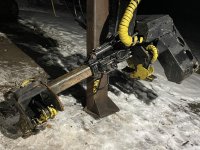https://www.youtube.com/watch?v=yh89snfBRFs
Wow, my jaw is on the floor.
I love the piece of line holding up the extra bight of hose or wire.
So was the final fix going to the HSC, getting the filtering right, and having the HSC internal count stop the motion (not in a PLC scan)?
And the dimples did not need to be munged at all?
Wow.
This video is exactly like my machine. The only difference is my excavator is orange! They really are cool machines. It had my interest, really is the only reason I got into them. Aside form the fact that we have been cutting with power saws to do our harvesting till now. I have a few in the neighborhood now that guys get me to help troubleshoot with. None are the 1000 model though, usually smaller ones. Normally its just failed sensors or broken wire and sometimes solenoid coils fry, but usually these things are bullet proof.
The dimples were not touched at all. In my original post, I stated that there was 14mm between the dimples, that was a typo, there is only 6mm. So On for 6, off for 14mm. It works impressively now!
"I love the piece of line holding up the extra bight of hose or wire."
That is a bungee cord that keeps the set of lines attached to the stroke head pulled back behind the machine. If they get in front of the machine, the tree limbs will brake them off. We replace a lot of lines!
So was the final fix going to the HSC, getting the filtering right, and having the HSC internal count stop the motion (not in a PLC scan)?
This is all true, except for the last part. I'm simply moving the value of the HSC counter to a routine that uses it to make a value in MM. That calculated value is what I use to measure. It adds every time the stroke IN happens and adds to the previous total until the target length is reached.
Of course it only accumulates in auto feeding mode, as sometimes with larger trees you will need to take over from the auto sequence and stroke in and out several times to smash off larger limbs, then continue auto sequencing where you left off. So long as the bottom grippers don't move on the log while manually stroking, it will keep its current log length accurately.
I suppose by doing as you suggest, using the internal count to stop motion on the final approach to the target could make it a bit shaper in design. But I'm very happy with it at this point.





